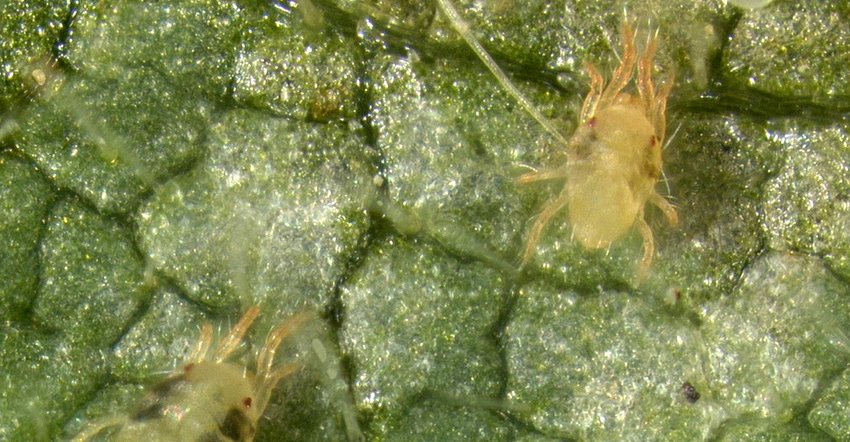
A warm winter for much of Missouri begs the question, "Will we have a hot, dry summer this year?" If so, Dawn Refsell says growers need to prepare for spider mites in soybeans.
Spider mites are a sporadic pest that resides mostly in the Midwest. Why? The hotter it is, the faster they reproduce, she says.
Refsell, who is the field development manager with Valent, covers four Midwestern states including her home base of Missouri. She finds that spider mites in soybean fields are an annual problem in states like Kansas and Nebraska, but have been popping up in Missouri fields. However, her company has a relatively new product for mite mitigation in ZealSC Miticide.
What are spider mites?
Spider mites are not insects; they are actually arachnids and belong to a large family of mites, Tetranychidae. They are known for producing webbing when their populations are high, thus inheriting their name — spider mites.
There are a number of species of spider mites, but the most common in the Midwest is the two-spotted spider mite (Tetranychidae urticae). This species gets its name from two darks spots on the sides of the abdomen and comes in many colors like greenish-yellow, white, orange or red. They are small in size, at about 1/60 of an inch, and feed on the underside of soybean leaves. This makes them difficult for many farmers to detect when scouting a field. But left undetected, these small arachnids can cause yield problems for soybean growers.

MITE INVASION: Soybean leaves turning brown or bronze is one symptom of two-spotted spider mites feeding. (Photo courtesy of Mike Ballweg, University of Wisconsin Extension)

The spider mite pierces individual plant cells with its mouthparts and feeds on the cells. The damage to the leaf starts appearing as spots, according to a University of Missouri Integrated Pest Management newsletter. With a heavy infestation, the leaves can turn yellow, then brown, and then finally drop from the plant. And excessive feeding can cause yield problems for soybean growers.
A control option
Refsell says Valent has a product that can help farmers fight spider mites. The company introduced ZealSC Miticide for soybeans last year.
"Zeal has a unique mode of action that different from other miticides," she says. "Farmers get residual control with Zeal at all life cycles of the mites."

MITICIDE SOLUTION: Farmers have a longer protection window against spider mites with Valent's ZealSC Miticide. This miticide's formulation provides for up to three weeks of residual protection after application, according to Dawn Refsell, field development manager with Valent.

The formulation stops egg, larva and nymph development on contact. Eggs laid by treated adults become sterile and will not hatch, Refsell adds. Spider mites can go through many generations each season, and in hot and dry conditions they can take as little as 10 days to complete development, according to research from South Dakota State University. "This is not just a knockdown treatment," Refsell says, "this is to prevent the next stage."
Zeal travels through the soybean leaf quickly to reach mites where they hide and feed, according to Refsell. It is a translaminar insecticide, which penetrates the leaf tissues and forms a pool of active ingredient within the leaf. This provides for the residual activity against the mites for at least three weeks — and in some cases, even more, she says.
Soybeans are the most recent registration for Zeal, following registration in field corn, cotton and melons.
Zeal is also farm-friendly. The low application rate of just 4 ounces of Zeal will treat most infestations, Refsell adds. Additionally, the liquid formulation of Zeal helps with ease of mixing.
About the Author(s)
You May Also Like






